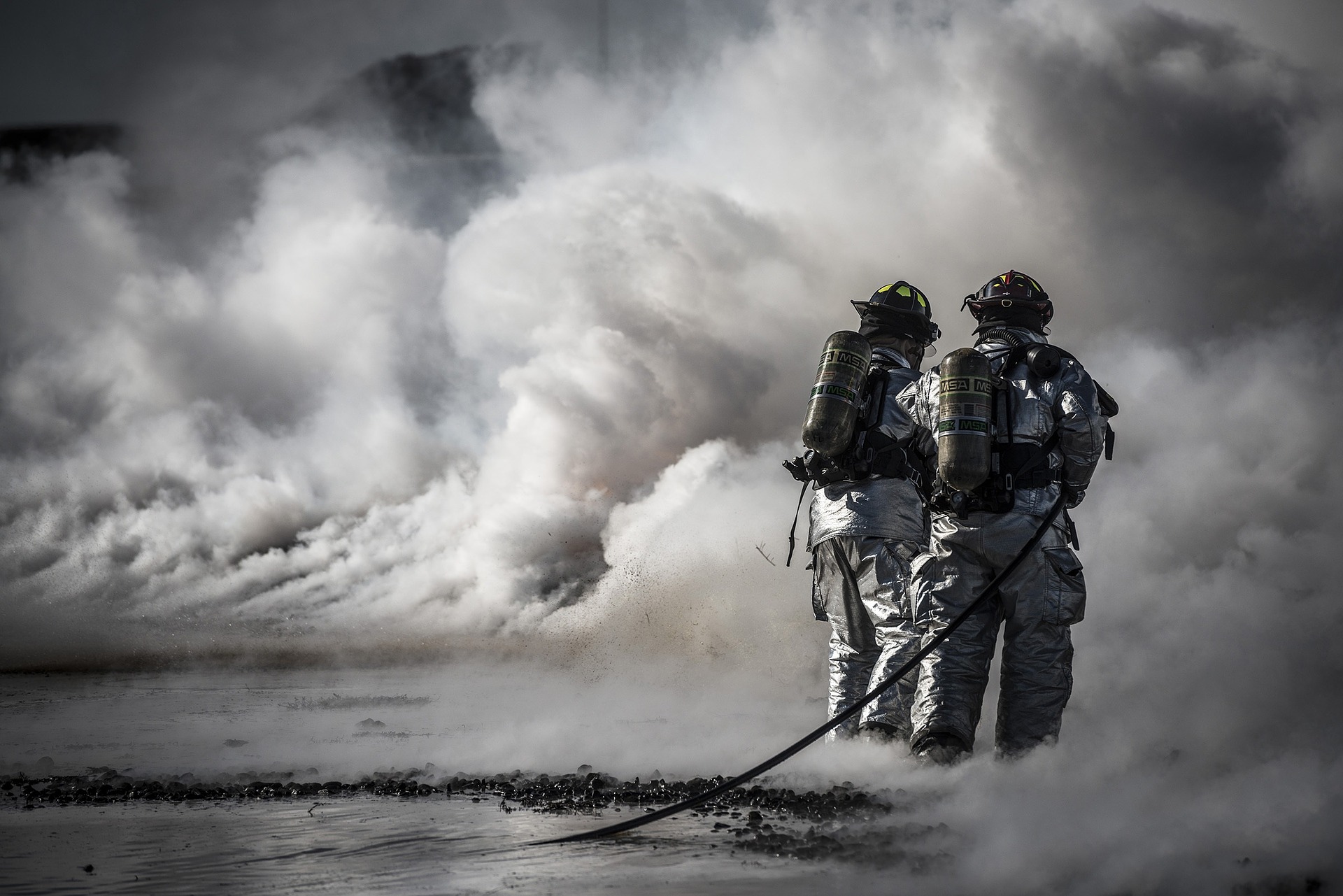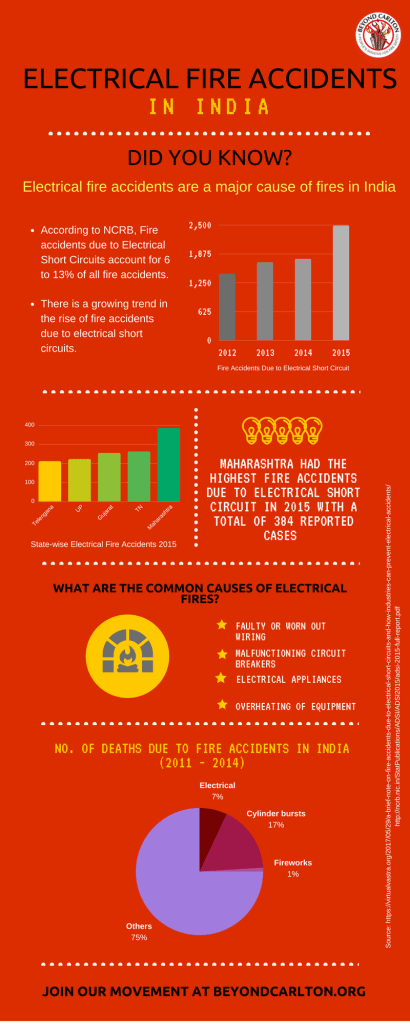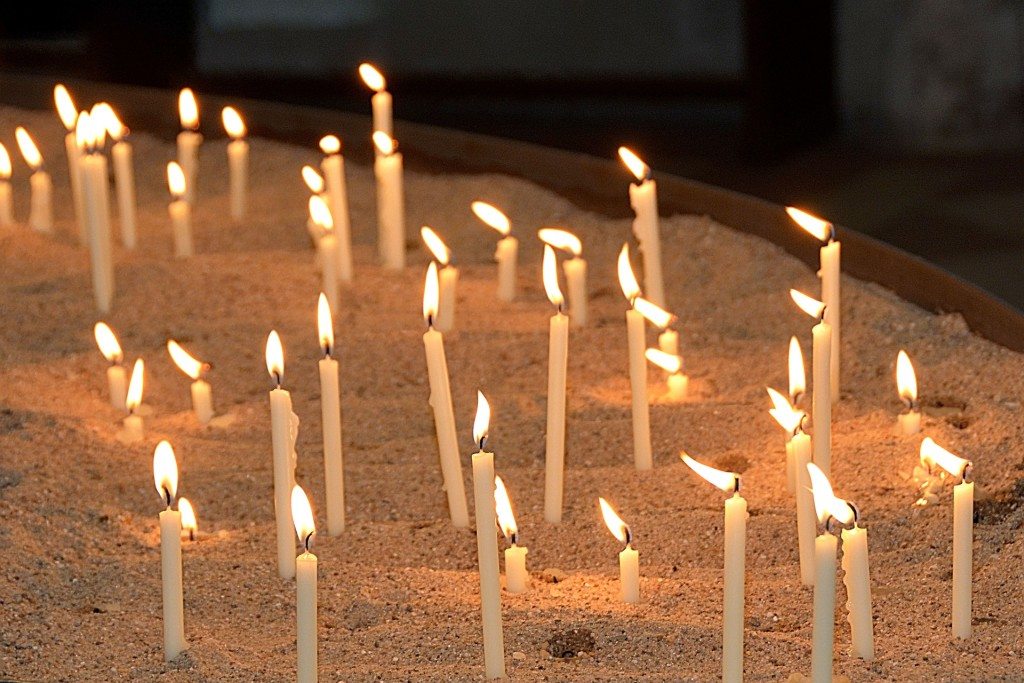
A Handy Guide For Electrical Fire Safety
In India, according to National Crime Records Bureau’s (NCRB) report, there were 7743 deaths in 5 years (from 2010 -14) due to accidental fires caused by electrical short circuits. Electrical fires are one of the major reasons for industrial fires as 56% of incidents are reportedly caused by electrical fires.
Electrical short circuits are the most common and most overlooked causes of fire accidents around the world.
The infographic below shows that there is a growing trend in the fire accidents due to electrical short circuits.
What are the causes of electrical fires?
- Frayed or Faulty wiring
Electrical fires are commonly caused by outdated and frayed wires. For homes older than 20-25 years, the capacity of the wires to handle the consumption of modern electrical equipment may not be sufficient. Often spikes in power consumption trigger the electrical circuit breakers to act. If the circuit breaker is worn out, it may not work properly in such instances. This results in electrical fires. Another common cause of the electrical fire is faulty wiring. If the electrician is not qualified, he may not follow the safety protocols that are required. Running a wrong wire on a wrong outlet may also cause fires.
- Extension cords
If you have too many appliances connected to an extension cord for a long duration, then it may cause an electrical fire. Extension cords are designed only for temporary usage. It is better to use the right outlet for electrical appliances.
- Electrical appliances
Electrical fires are even caused by old and damaged electrical appliances. Do not use an appliance with damaged or frayed wires. The frayed cords could transfer heat to combustible materials like carpets, curtains or wood and result in a fire.
- Outdated circuit breakers
Electrical circuit breakers play an important role in preventing electrical fires. Circuit breakers may not withstand the power fluctuations or continuous overloads caused by electrical equipment like air conditioners and water heaters. Mostly during every instance of overloading, your circuit breaker may trip. Slowly, these may result in malfunctioning of circuit breakers. In order to avoid this, it is better to keep checking the circuit breaker if you have more than two occasions of tripping.
- Light fixtures and decorations
Another largest cause of electrical fires is light fixtures. Before installing lights for your home, it is important to check the light fixture for the level of heat it can withstand. Using light bulbs with higher wattage may cause an electrical fire.
If you are using decorative serial lights, it is very important to ensure that the cords are not in contact with any combustible materials. It is even riskier if it is used in an extension cord. It is important to use these lights only when you need to. Unattended serial lights could also result in a fire.
- Electrical switches and outlets
Old and worn out switches also cause electrical fires. Also, worn out plug points that have sporadic power supply also may require attention from you from time to time. If these are not attended, it may lead to heating and could result in a fire.
- Unattended charging points
It is for sheer convenience we often connect our laptops or mobile phones to a dedicated charging point in our homes. We seldom switch off the plug, whether it is in use or not. This may not look like a problem at the outset as there is no immediate threat of a fire. But when the circuit releases heat it gets slowly accumulated. When this is in contact with wood or fabric it can ignite and cause a fire.
A summary of precautions to take for electrical fire safety
General electrical safety in your home
- Do not use extension cords to connect electrical appliances. Use extension cords only for temporary purposes.
- Do not run wires under carpets or rugs.
- Do not use cords that are worn out or frayed
- Check the circuit breakers once every year. If you have more instances of tripping. Get a qualified electrician to have the breaker checked.
- Disconnect mobile chargers or laptop chargers when not in use.
- Replace outdated and worn out electrical appliances and switches.
- Use light fixtures only with the recommended wattage of lights.
- Clear the electrical systems regularly for any dust, trash or spider webs. As these can catch fire whenever there is a heating.
Electrical Appliances
Electrical Appliances like refrigerators, washing machine, air conditioners, microwave ovens, dryers, stoves, etc should be plugged directly into the plug points in the wall. Do not use extension cords for these appliances.
Circuit breakers
Install an electrical circuit breaker. A circuit breaker shuts the power supply whenever there is a power leakage or fault. This is called tripping.
Whenever there is a tripping. Have a qualified electrician to check the condition of the electrical circuit breaker. Remember, a malfunctioning circuit breaker would also cause heating and electrical fires.
What should you do when there is an electrical fire?
If there is a fire due to the electrical short circuit:
- Switch off the electrical system.
- Treat the fire as ‘class A’ for extinguishing purpose.
- If you can’t isolate the power supply, use non-electrical conducting extinguishing agents. regardless of the power status. (Refer to the different classes of fire)
When to call a qualified electrician?
- If your electrical circuit breakers are frequently tripping.
- Whenever you touch an electrical appliance, you have a tingling feeling.
- The wall outlets are warm or burnt or discolored.
- There is a burning smell from an appliance.
- The lights in your home are flickering.
- If any outlets have sparks coming out of it.
It is much easier to prevent an electrical fire if you are preventive. Share it with your friends and spread awareness about fire safety.

















 are highly flammable. A kitchen houses all sorts of cleaning chemicals – so do the storage areas in office buildings. If one goes to basements or garages, there’s motor oils and fuel aplenty. Anything – from overloaded of electrical circuits, chafed and old wiring, broken plugs or switches, and fuses of wrong rating, to sparks, defective electrical equipment and wiring, and artificial fabrics near flames – can be the cause of a deadly fire. Non-functional fire-extinguishers, locked exits, perceived non-importance of fire drills, closed valves, inadequate fire protection systems, the absence of or non-functional fire alarms – these have rendered us fools who learn only much after irreversible damage.
are highly flammable. A kitchen houses all sorts of cleaning chemicals – so do the storage areas in office buildings. If one goes to basements or garages, there’s motor oils and fuel aplenty. Anything – from overloaded of electrical circuits, chafed and old wiring, broken plugs or switches, and fuses of wrong rating, to sparks, defective electrical equipment and wiring, and artificial fabrics near flames – can be the cause of a deadly fire. Non-functional fire-extinguishers, locked exits, perceived non-importance of fire drills, closed valves, inadequate fire protection systems, the absence of or non-functional fire alarms – these have rendered us fools who learn only much after irreversible damage.

